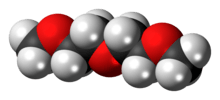Diglyme
 | |
| Names | |
|---|---|
| Preferred IUPAC name
1-Methoxy-2-(2-methoxyethoxy)ethane[1] | |
| Other names
Diglyme 2-Methoxyethyl ether Di(2-methoxyethyl) ether Diethylene glycol dimethyl ether | |
| Identifiers | |
3D model (JSmol) |
|
| ChEBI | |
| ChemSpider | |
| DrugBank | |
| ECHA InfoCard | 100.003.568 |
| EC Number | 203-924-4 |
PubChem CID |
|
| UNII | |
| |
| |
| Properties | |
| C6H14O3 | |
| Molar mass | 134.18 g·mol−1 |
| Density | 0.937 g/mL |
| Melting point | −64 °C (−83 °F; 209 K) |
| Boiling point | 162 °C (324 °F; 435 K) |
| miscible | |
| Hazards | |
EU classification (DSD) (outdated) |
Toxic (T) Flammable (F) |
| R-phrases (outdated) | R60 R61 R10 R19 |
| S-phrases (outdated) | S53 S45 |
| Flash point | 57 °C (135 °F; 330 K) |
| Related compounds | |
Related compounds |
Diethylene glycol diethyl ether, ethylene glycol dimethyl ether |
Except where otherwise noted, data are given for materials in their standard state (at 25 °C [77 °F], 100 kPa). | |
| Infobox references | |
Diglyme, or bis(2-methoxyethyl) ether, is a solvent with a high boiling point. It is an organic compound which is the dimethyl ether of diethylene glycol. (The name "diglyme" is a portmanteau of "diglycol methyl ether.") It is a clear, colorless liquid with a slight ether-like odor. It is miscible with water, alcohols, diethyl ether, and hydrocarbon solvents. It is prepared by a reaction of dimethyl ether and ethylene oxide over an acid catalyst.[2]
Solvent
Its stability, even at high pH values, makes it an excellent solvent for reactions with strong bases or reactions that require high temperatures.
Diglyme is mainly used as a solvent. It serves as a chelate for alkali metal cations, leaving anions more active. Therefore, reactions involving organometallic reagents, such as Grignard reactions or metal hydride reductions, may have significantly enhanced reaction rates.[3] Diglyme is also used as a solvent in hydroboration reactions with diborane.
References
- ↑ Nomenclature of Organic Chemistry : IUPAC Recommendations and Preferred Names 2013 (Blue Book). Cambridge: The Royal Society of Chemistry. 2014. p. 704. doi:10.1039/9781849733069-FP001. ISBN 978-0-85404-182-4.
- ↑ Siegfried Rebsdat; Dieter Mayer, "Ethylene Glycol", Ullmann's Encyclopedia of Industrial Chemistry, Weinheim: Wiley-VCH, doi:10.1002/14356007.a10_101
- ↑ J. E. Ellis, A. Davison (1976). "Tris[Bis(2-Methoxyethyl)Ether]Potassium and Tetraphenylarsonium Hexacarbonylmetallates(1–) of Niobium and Tantalum". Inorg. Synth. 16: 68–73. doi:10.1002/9780470132470.ch21.